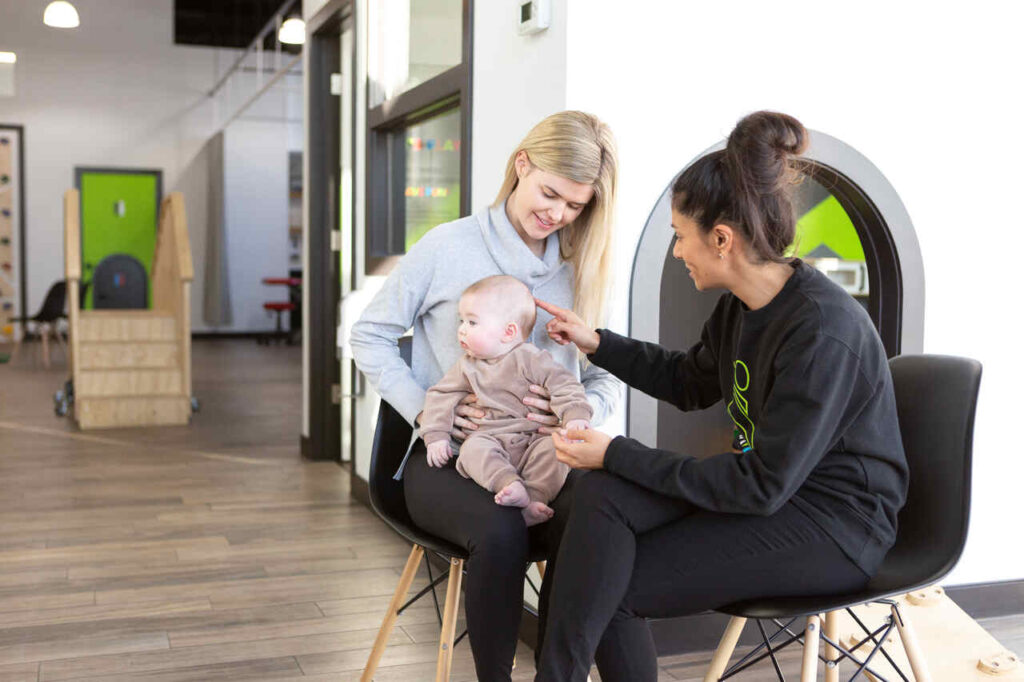Written by Gina Rolf, Physiotherapist
As a peak health physiotherapist who works with kids, I am frequently asked about two common conditions in babies: torticollis and plagiocephaly. While they may sound like tongue twisters, these conditions can have significant impacts on a child’s development. In this blog post, we will explore these conditions, including their causes, effects, and treatments.
What Is The Difference Between Torticollis and Plagiocephaly?
First, let’s define what these terms mean. Torticollis is a condition in which an infant’s neck is tilted to one side, resulting in difficulty turning the head in the opposite direction. Plagiocephaly, on the other hand, is a condition in which an infant’s head becomes flattened on one side, due to various factors such as a preference for sleeping or turning to that side.
Is Torticollis Associated With Plagiocephaly?
So, are these two conditions related? The answer is yes. In fact, torticollis is a common cause of plagiocephaly. When an infant’s neck is constantly tilted to one side, the weight of their head can cause flattening on that side, leading to plagiocephaly.
Does Physical Therapy Help Torticollis and Plagiocephaly?
The answer to this one is also yes! Physical therapy is often recommended as the first line of treatment for both torticollis and plagiocephaly.
In the case of torticollis, physical therapy can help to stretch and strengthen the muscles in the neck, allowing for a better range of motion and improved head control. During an appointment, your physiotherapist will review the specific stretches prescribed for your child, as well as ensure all developmental milestones are being met and not being adversely influenced by the torticollis.
For plagiocephaly, physical therapy can help to improve the baby’s overall alignment, reduce the asymmetry in the head shape, and promote the use of both sides of the body. In some cases, treating in conjunction with a remolding orthosis (more commonly known as a helmet) may be recommended to help direct the growth of your baby’s head. If this is the case, your pediatric physiotherapist will help facilitate this process with other clinics in the city.
At What Age Is Plagiocephaly Permanent?
It’s important to note that physical therapy is not a one-size-fits-all solution. Each baby’s treatment plan will be tailored to their specific needs, based on the severity of their condition and their age. The good news is that plagiocephaly is not usually permanent, especially if it is caught early and treated appropriately. In fact, most cases of plagiocephaly will resolve with a combination of physical therapy and repositioning techniques before the baby turns one year old.
What Happens If Torticollis is Left Untreated?
Unfortunately, untreated torticollis can lead to a host of other problems, including delayed motor development, difficulty with visual tracking, and even facial asymmetry. That’s why it’s so important to seek treatment as soon as possible if you suspect your child has torticollis.
What Happens If You Don’t Correct Plagiocephaly?
While plagiocephaly is not usually permanent, leaving it untreated can lead to long-term problems, such as facial asymmetry, jaw misalignment, and even developmental delays. Again, seeking treatment as soon as possible is key to ensuring the best possible outcomes for your child.
Key Takeaways
In conclusion, while torticollis and plagiocephaly can be concerning for parents, it is rarely permanent. With the right treatment, such as the stretches and exercises learned during physical therapy, most infants and young children can overcome these conditions and go on to develop normally with an improved quality of life.
So, if you suspect your child has torticollis or plagiocephaly, don’t hesitate to reach out to me or anyone from our team at Peak Health Kids. Together, we can help your child achieve their full potential! Click HERE to learn more.

